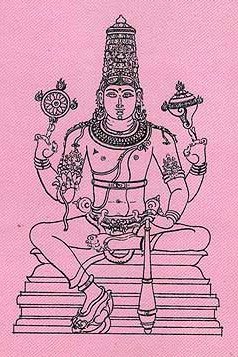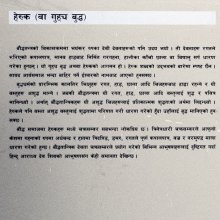Aradhya, Ārādhya: 14 definitions
Introduction:
Aradhya means something in Hinduism, Sanskrit, Jainism, Prakrit, the history of ancient India, Marathi, Hindi. If you want to know the exact meaning, history, etymology or English translation of this term then check out the descriptions on this page. Add your comment or reference to a book if you want to contribute to this summary article.
Alternative spellings of this word include Aradhy.
Images (photo gallery)
In Hinduism
Pancaratra (worship of Nārāyaṇa)
Source: University of Vienna: Sudarśana's Worship at the Royal Court According to the AhirbudhnyasaṃhitāĀrādhya (आराध्य) refers to “propitiation” (of a deity), according to the Ahirbudhnyasaṃhitā, belonging to the Pāñcarātra tradition which deals with theology, rituals, iconography, narrative mythology and others.—Accordingly, “Without the propitiation (an-ārādhya) of this Deity there just can be no King”.

Pancaratra (पाञ्चरात्र, pāñcarātra) represents a tradition of Hinduism where Narayana is revered and worshipped. Closeley related to Vaishnavism, the Pancaratra literature includes various Agamas and tantras incorporating many Vaishnava philosophies.
Shaktism (Shakta philosophy)
Source: Google Books: ManthanabhairavatantramĀrādhya (आराध्य) refers to the “object of adoration”, according to the Manthānabhairavatantra, a vast sprawling work that belongs to a corpus of Tantric texts concerned with the worship of the goddess Kubjikā.—Accordingly, “The Venerable House is the arising of the Western (transmission). Free by virtue of the practice of Kula, it is the object of adoration (ārādhya) of all the gods, Skyfarers and yogis and is attended by the Mothers, Yoginīs, Vīras, Bhairavas, and Rudras. [...]

Shakta (शाक्त, śākta) or Shaktism (śāktism) represents a tradition of Hinduism where the Goddess (Devi) is revered and worshipped. Shakta literature includes a range of scriptures, including various Agamas and Tantras, although its roots may be traced back to the Vedas.
In Jainism
General definition (in Jainism)
Source: The University of Sydney: A study of the Twelve ReflectionsĀrādhya (आराध्य) refers to “having honoured”, according to the 11th century Jñānārṇava, a treatise on Jain Yoga in roughly 2200 Sanskrit verses composed by Śubhacandra.—Accordingly, “O fool, sentient beings, having begun from the womb, are continually led by [their own] action to Yama’s abode by means of uninterrupted journeys. If there is a powerful [man], seen or heard about, who opposes the command of Yama, having honoured (ārādhya) him you must possess health. [As there is] no such individual, why [make] the effort [for health] in vain?”.

Jainism is an Indian religion of Dharma whose doctrine revolves around harmlessness (ahimsa) towards every living being. The two major branches (Digambara and Svetambara) of Jainism stimulate self-control (or, shramana, ‘self-reliance’) and spiritual development through a path of peace for the soul to progess to the ultimate goal.
India history and geography
Source: Cologne Digital Sanskrit Dictionaries: Indian Epigraphical GlossaryĀrādhya.—(EI 15), ‘the worshipful one’; title of certain Śaivite Brāhmaṇas of Karṇāṭaka. Note: ārādhya is defined in the “Indian epigraphical glossary” as it can be found on ancient inscriptions commonly written in Sanskrit, Prakrit or Dravidian languages.

The history of India traces the identification of countries, villages, towns and other regions of India, as well as mythology, zoology, royal dynasties, rulers, tribes, local festivities and traditions and regional languages. Ancient India enjoyed religious freedom and encourages the path of Dharma, a concept common to Buddhism, Hinduism, and Jainism.
Languages of India and abroad
Marathi-English dictionary
Source: DDSA: The Molesworth Marathi and English Dictionaryārādhya (आराध्य).—a S ārādhanīya a S To be worshiped or adored; to be served, courted, or conciliated.
--- OR ---
ārādhya (आराध्य).—n S or ārādhyadēvatā f (S) ārādhya daivata n (S) The tutelar deity of a family, the household-god; and pl the Lares or Penates.
Marathi is an Indo-European language having over 70 million native speakers people in (predominantly) Maharashtra India. Marathi, like many other Indo-Aryan languages, evolved from early forms of Prakrit, which itself is a subset of Sanskrit, one of the most ancient languages of the world.
Sanskrit dictionary
Source: DDSA: The practical Sanskrit-English dictionaryĀrādhya (आराध्य).—pot. p.
1) Fit to be worshipped or propitiated; सोऽहं कथं नाम तवाचरेयमाराधनीयस्य ऋषेर्विधानम् (so'haṃ kathaṃ nāma tavācareyamārādhanīyasya ṛṣervidhānam) R.16.82.
2) To become accomplished.
See also (synonyms): ārādhanīya.
Source: Cologne Digital Sanskrit Dictionaries: Cappeller Sanskrit-English DictionaryĀrādhya (आराध्य).—[adjective] to be made favourable, to be won.
Source: Cologne Digital Sanskrit Dictionaries: Monier-Williams Sanskrit-English Dictionary1) Ārādhya (आराध्य):—[=ā-rādhya] [from ā-rādh] mfn. to be made favourable
2) [v.s. ...] to be worshipped, [Kathāsaritsāgara; Bhartṛhari; Pañcatantra]
3) [v.s. ...] to be accomplished, [Sāhitya-darpaṇa; Kāvyaprakāśa]
Source: DDSA: Paia-sadda-mahannavo; a comprehensive Prakrit Hindi dictionary (S)Ārādhya (आराध्य) in the Sanskrit language is related to the Prakrit words: Ārajjha, Ārāha.
[Sanskrit to German]
Sanskrit, also spelled संस्कृतम् (saṃskṛtam), is an ancient language of India commonly seen as the grandmother of the Indo-European language family (even English!). Closely allied with Prakrit and Pali, Sanskrit is more exhaustive in both grammar and terms and has the most extensive collection of literature in the world, greatly surpassing its sister-languages Greek and Latin.
Hindi dictionary
Source: DDSA: A practical Hindi-English dictionaryĀrādhya (आराध्य) [Also spelled aradhy]:—(a) adorable, worthy of worship; (nm) the adored one (esp. a deity).
...
Kannada-English dictionary
Source: Alar: Kannada-English corpusĀrādhya (ಆರಾಧ್ಯ):—[adjective] worthy of being adored, worshipped or revered; adorable.
--- OR ---
Ārādhya (ಆರಾಧ್ಯ):—
1) [noun] a sect in Vīraśaiva religion.
2) [noun] a member of this sect.
3) [noun] a man worthy of respect; a venerable man.
Kannada is a Dravidian language (as opposed to the Indo-European language family) mainly spoken in the southwestern region of India.
Nepali dictionary
Source: unoes: Nepali-English DictionaryĀrādhya (आराध्य):—adj. to be worshipped; adored;
Nepali is the primary language of the Nepalese people counting almost 20 million native speakers. The country of Nepal is situated in the Himalaya mountain range to the north of India.
See also (Relevant definitions)
Starts with: Aradhyadevata, Aradhyakarpura, Aradhyamana.
Ends with: Adhikaradhya, Anaradhya, Daradhya, Duraradhya, Jagadaradhya, Kesharadhya, Paramaradhya, Praradhya, Samaradhya, Sukharadhya, Uparadhya, Virannaradhya, Vishnudevaradhya, Yajnaradhya.
Full-text: Arajjha, Aradhyakarpura, Duraradhya, Aradhaniya, Arattiyar, Irevanarattiyar, Sukharadhya, Siddhantacintaratnasamgraha, Vipakshashula, Aradhy, Shivatatvasaram, Siddhantashikhamani, Aryabhatasiddhanta, Araha, Induluri, Pitri, Parikarman, Sarga, Arya.
Relevant text
Search found 15 books and stories containing Aradhya, Ārādhya, A-radhya, Ā-rādhya; (plurals include: Aradhyas, Ārādhyas, radhyas, rādhyas). You can also click to the full overview containing English textual excerpts. Below are direct links for the most relevant articles:
Chaitanya Bhagavata (by Bhumipati Dāsa)
Verse 2.1.284 < [Chapter 1 - The Beginning of the Lord’s Manifestation and His Instructions on Kṛṣṇa-saṅkīrtana]
Lord Jhulelal: An Analytical Study (by Thakkar Harish Gopalji)
Part 5.11 - Aradhya Dev Varunavatar < [Chapter 2 - Literature Review]
Part 5.2 - Literature Reviews (Introduction) < [Chapter 2 - Literature Review]
Brihad Bhagavatamrita (commentary) (by Śrī Śrīmad Bhaktivedānta Nārāyana Gosvāmī Mahārāja)
Verse 1.3.15 < [Chapter 3 - Prapañcātīta (beyond the Material Plane)]
Verse 1.3.66 < [Chapter 3 - Prapañcātīta (beyond the Material Plane)]
Verse 1.2.89-90 < [Chapter 2 - Divya (the celestial plane)]
Book Reviews < [October – December 1991]
The Lingayats-Their Religion and Literature < [May 1937]
The Agni Purana (by N. Gangadharan)
Sahitya-kaumudi by Baladeva Vidyabhushana (by Gaurapada Dāsa)
Text 10.183 < [Chapter 10 - Ornaments of Meaning]
